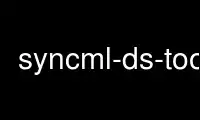
This is the command syncml-ds-tool that can be run in the OnWorks free hosting provider using one of our multiple free online workstations such as Ubuntu Online, Fedora Online, Windows online emulator or MAC OS online emulator
PROGRAM:
NAME
syncml-ds-tool - A SyncML Data Synchronization tool for Unix. The syncml-ds-tool supports
OMA DS server and client mode. Additionally OBEX and HTTP transports are supported in
client and server mode.
SYNOPSIS
syncml-ds-tool 'OPTIONS' ...
OPTIONS
Datastore configuration
Parameters:
–sync '<type>' '<path>' '<directory>' normal two-way sync
–slow-sync '<type>' '<path>' '<directory>' slow two-way sync
· type is the content-type of a datastore text/x-vcard for contacts text/x-vcalendar for
calendar text/plain for notes text/x-vMessage for SMS
· path is the used (virtual) source URL/path It is the local name of the database. You can
choose something there.
· directory is the local path to the synchronized directory The directory is optional and
an absolute path. This directory is a persistent storage.
HTTP client configuration
Parameters:
–http-client '<url>'
· url must be an http URL like http://localhost:8080
HTTP server configuration
Parameters:
–http-server '<port>'
· port must be a port for the http server.
OBEX client configuration
Parameters:
-s '<device>' Connect to the serial device.
-u List all available USB interfaces.
-u '<id>' Connect to the given usb interface number. You may discover them with -u.
-b '<addr>' '<channel>' Connect to the given bluetooth device.
–ip '<addr>' '<port>' Connect to this TCP/IP address.
–irda Connect using IrDA.
–irda-service '<service>' Use the given IrDA service (default: OBEX).
OBEX server configuration
Parameters:
–port '<port>' Listen to this TCP/IP port.
General SyncML options
Parameters:
–identifier '<ident>' set the local identity of SyncML (source).
–target '<ident>' set the remote identity of SyncML (target).
–username '<username>' set the username for authentication.
–password '<password>' set the password for authentication.
–maxMsgSize '<limit>' set the maximum message size (default: 0)
–maxObjSize* '<limit>' set the maximum object size (default: 0)
–useStringTable Use wbxml string tables (default: NEVER EVER)
–disableNumberOfChanges the most new phones support it (default: enabled)
–useNumberAnchor Use numbers as anchors.
–wbxml Use wbxml (WAP Binary XML) instead of plain xml.
–read-only No write actions will be performed.
–remoteWinsConflicts If there is a conflict then the remote change wins. The
default is local wins always. This option is only usable in OMA DS server mode.
–dumpinfo Print info about the phone.
–version prints the version of the tool.
–version '<version>' sets the SyncML version.
· ident Some devices require a special identity string. Nokias for example often requires
'PC Suite'. Please use --identifier 'PC Suite' in this case.
· version can be '1.0', '1.1' or '1.2'. The default version is '1.1'.
Device faking options
Some SyncML servers try to enforce access policies via device filtering. These options can
be used to work around such filters.
Parameters:
–fake-manufacturer '<Man>' set the manufacturer of the faked device.
–fake-model '<Mod>' set the model of the faked device.
–fake-software-version '<SwV>' set the software version of the faked device.
EXAMPLES
Get the contacts from your phone via Bluetooth
$ syncml-ds-tool -b <mac> <channel> --slow-sync text/x-vcard contacts --wbxml --identifier "PC Suite"
Get the notes from a USB connected phone
$ syncml-ds-tool -u <interface> --slow-sync text/plain notes --wbxml --identifier "PC Suite"
Use syncml-ds-tool online using onworks.net services
